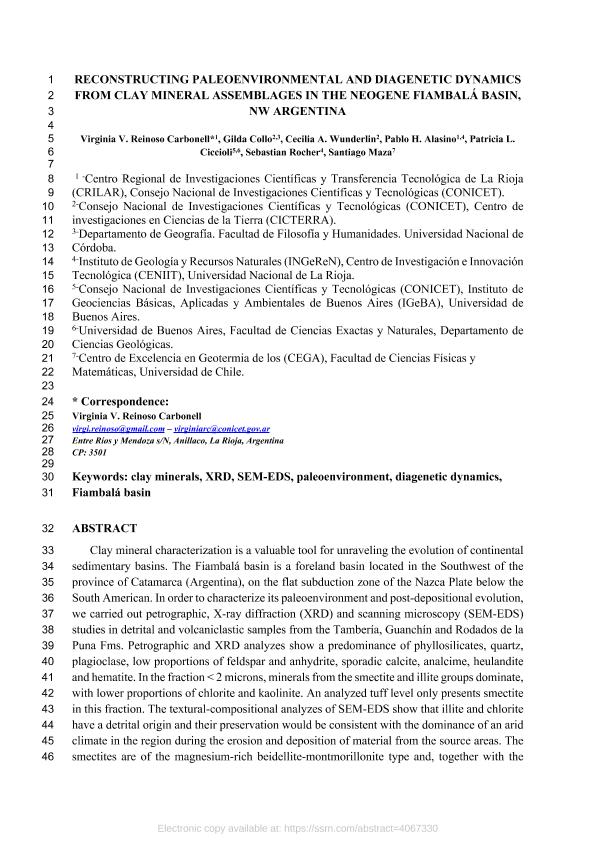Artículo
Reconstructing paleoenvironmental and diagenetic dynamics from clay mineral assemblages in the Neogene Fiambalá Basin, NW Argentina
Reinoso Carbonell, Virginia Valeria ; Collo, Gilda
; Collo, Gilda ; Wunderlin, Cecilia Ayelén
; Wunderlin, Cecilia Ayelén ; Alasino, Pablo Horacio
; Alasino, Pablo Horacio ; Ciccioli, Patricia Lucia
; Ciccioli, Patricia Lucia ; Rocher, Sebastian
; Rocher, Sebastian ; Maza, Santiago
; Maza, Santiago
 ; Collo, Gilda
; Collo, Gilda ; Wunderlin, Cecilia Ayelén
; Wunderlin, Cecilia Ayelén ; Alasino, Pablo Horacio
; Alasino, Pablo Horacio ; Ciccioli, Patricia Lucia
; Ciccioli, Patricia Lucia ; Rocher, Sebastian
; Rocher, Sebastian ; Maza, Santiago
; Maza, Santiago
Fecha de publicación:
06/2022
Editorial:
Elsevier
Revista:
Social Science Research Network
ISSN:
1556-5068
Idioma:
Inglés
Tipo de recurso:
Artículo publicado
Clasificación temática:
Resumen
Clay mineral characterization is a valuable tool for unraveling the evolution of continental sedimentary basins. The Fiambalá basin is a foreland basin located in the Southwest of the province of Catamarca (Argentina), on the flat subduction zone of the Nazca Plate below the South American. In order to characterize its paleoenvironment and post-depositional evolution, we carried out petrographic, X-ray diffraction (XRD) and scanning microscopy (SEM-EDS) studies in detrital and volcaniclastic samples from the Tambería, Guanchín and Rodados de la Puna Fms. Petrographic and XRD analyzes show a predominance of phyllosilicates, quartz, plagioclase, low proportions of feldspar and anhydrite, sporadic calcite, analcime, heulandite and hematite. In the fraction < 2 microns, minerals from the smectite and illite groups dominate, with lower proportions of chlorite and kaolinite. An analyzed tuff level only presents smectite in this fraction. The textural-compositional analyzes of SEM-EDS show that illite and chlorite have a detrital origin and their preservation would be consistent with the dominance of an arid climate in the region during the erosion and deposition of material from the source areas. The smectites are of the magnesium-rich beidellite-montmorillonite type and, together with the zeolites would be authigenic generated as a product of the alteration of the volcanic material and magnesian detrital phases (chlorite and biotite), possibly under the influence of an alkaline environment related to the arid climate. From a thermal point of view, the presence of smectite throughout all stratigraphic succession allows interpreting maximum temperatures that, even in the deepest levels of the basin, inhibit the development of prograde phases (such as smectite/illite and smectite/chlorite mixed-layered) and allow the preservation of smectite. Paleogeothermal gradients of between 13 and 18 °C/km and between 8 and 11 °C/km, could be estimated considering thicknesses of ca. 4000 m and ca. 6400 m, respectively.
Palabras clave:
CLAY MINERALS
,
XRD
,
SEM-EDS
,
PALEOENVIRONMENT
,
DIAGENETIC DYNAMICS
,
FIAMBALÁ BASIN
Archivos asociados
Licencia
Identificadores
Colecciones
Articulos(CICTERRA)
Articulos de CENTRO DE INVEST.EN CS.DE LA TIERRA
Articulos de CENTRO DE INVEST.EN CS.DE LA TIERRA
Articulos(CRILAR)
Articulos de CENTRO REGIONAL DE INV. CIENTIFICAS Y TRANSFERENCIA TECNOLOGICA DE ANILLACO
Articulos de CENTRO REGIONAL DE INV. CIENTIFICAS Y TRANSFERENCIA TECNOLOGICA DE ANILLACO
Articulos(SEDE CENTRAL)
Articulos de SEDE CENTRAL
Articulos de SEDE CENTRAL
Citación
Reinoso Carbonell, Virginia Valeria; Collo, Gilda; Wunderlin, Cecilia Ayelén; Alasino, Pablo Horacio; Ciccioli, Patricia Lucia; et al.; Reconstructing paleoenvironmental and diagenetic dynamics from clay mineral assemblages in the Neogene Fiambalá Basin, NW Argentina; Elsevier; Social Science Research Network; 6-2022; 1-24
Compartir
Altmétricas



